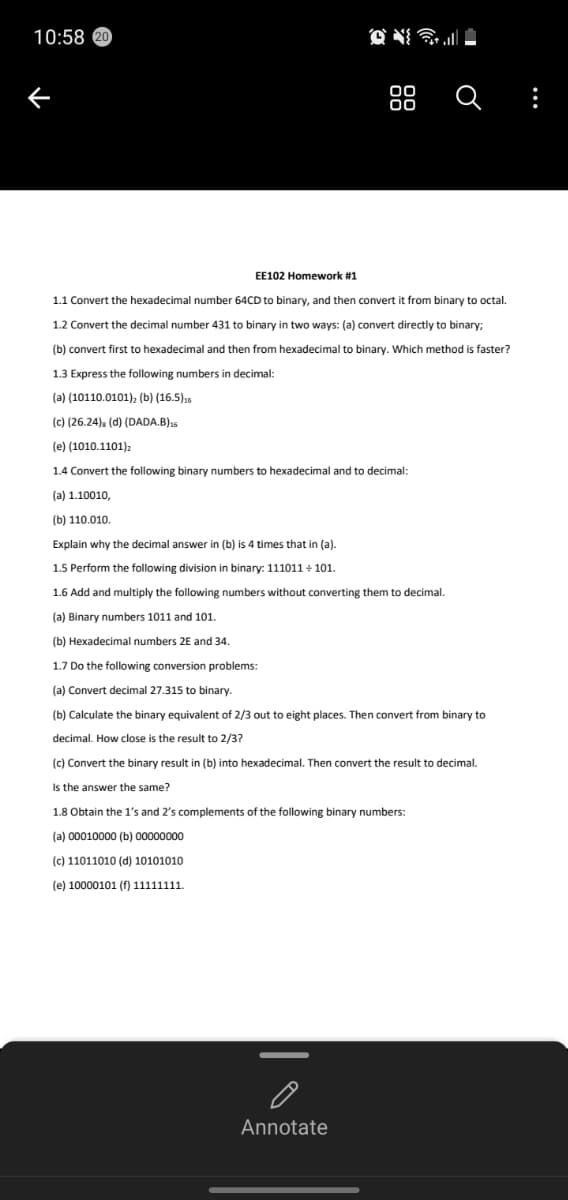EE102 Homework #1 1.1 Convert the hexadecimal number 64CD to binary, and then convert it from binary to octal. 1.2 Convert the decimal number 431 to binary in two ways: (a) convert directly to binary; (b) convert first to hexadecimal and then from hexadecimal to binary. Which method is faster? 1.3 Express the following numbers in decimal: (a) (10110.0101), (b) (16.5)s (c) (26.24), (d) (DADA.B).s (e) (1010.1101):
EE102 Homework #1 1.1 Convert the hexadecimal number 64CD to binary, and then convert it from binary to octal. 1.2 Convert the decimal number 431 to binary in two ways: (a) convert directly to binary; (b) convert first to hexadecimal and then from hexadecimal to binary. Which method is faster? 1.3 Express the following numbers in decimal: (a) (10110.0101), (b) (16.5)s (c) (26.24), (d) (DADA.B).s (e) (1010.1101):
Database System Concepts
7th Edition
ISBN:9780078022159
Author:Abraham Silberschatz Professor, Henry F. Korth, S. Sudarshan
Publisher:Abraham Silberschatz Professor, Henry F. Korth, S. Sudarshan
Chapter1: Introduction
Section: Chapter Questions
Problem 1PE
Related questions
Question
Computer Science

Transcribed Image Text:10:58 20
88 Q :
EE102 Homework #1
1.1 Convert the hexadecimal number 64CD to binary, and then convert it from binary to octal.
1.2 Convert the decimal number 431 to binary in two ways: (a) convert directly to binary;
(b) convert first to hexadecimal and then from hexadecimal to binary. Which method is faster?
1.3 Express the following numbers in decimal:
(a) (10110.0101); (b) (16.5)16
(c) (26.24)s (d) (DADA.B)15
(e) (1010.1101)2
1.4 Convert the following binary numbers to hexadecimal and to decimal:
(a) 1.10010,
(b) 110.010
Explain why the decimal answer in (b) is 4 times that in (a).
1.5 Perform the following division in binary: 111011 + 101.
1.6 Add and multiply the following numbers without converting them to decimal.
(a) Binary numbers 1011 and 101.
(b) Hexadecimal numbers 2E and 34.
1.7 Do the following conversion problems:
(a) Convert decimal 27.315 to binary.
(b) Calculate the binary equivalent of 2/3 out to eight places. Then convert from binary to
decimal. How close is the result to 2/3?
(c) Convert the binary result in (b) into hexadecimal. Then convert the result to decimal.
Is the answer the same?
1.8 Obtain the 1's and 2's complements of the following binary numbers:
(a) 00010000 (b) 00000000
(c) 11011010 (d) 10101010
(e) 10000101 (f) 11111111.
Annotate
Expert Solution
This question has been solved!
Explore an expertly crafted, step-by-step solution for a thorough understanding of key concepts.
This is a popular solution!
Trending now
This is a popular solution!
Step by step
Solved in 4 steps

Knowledge Booster
Learn more about
Need a deep-dive on the concept behind this application? Look no further. Learn more about this topic, computer-science and related others by exploring similar questions and additional content below.Recommended textbooks for you

Database System Concepts
Computer Science
ISBN:
9780078022159
Author:
Abraham Silberschatz Professor, Henry F. Korth, S. Sudarshan
Publisher:
McGraw-Hill Education

Starting Out with Python (4th Edition)
Computer Science
ISBN:
9780134444321
Author:
Tony Gaddis
Publisher:
PEARSON

Digital Fundamentals (11th Edition)
Computer Science
ISBN:
9780132737968
Author:
Thomas L. Floyd
Publisher:
PEARSON

Database System Concepts
Computer Science
ISBN:
9780078022159
Author:
Abraham Silberschatz Professor, Henry F. Korth, S. Sudarshan
Publisher:
McGraw-Hill Education

Starting Out with Python (4th Edition)
Computer Science
ISBN:
9780134444321
Author:
Tony Gaddis
Publisher:
PEARSON

Digital Fundamentals (11th Edition)
Computer Science
ISBN:
9780132737968
Author:
Thomas L. Floyd
Publisher:
PEARSON

C How to Program (8th Edition)
Computer Science
ISBN:
9780133976892
Author:
Paul J. Deitel, Harvey Deitel
Publisher:
PEARSON

Database Systems: Design, Implementation, & Manag…
Computer Science
ISBN:
9781337627900
Author:
Carlos Coronel, Steven Morris
Publisher:
Cengage Learning

Programmable Logic Controllers
Computer Science
ISBN:
9780073373843
Author:
Frank D. Petruzella
Publisher:
McGraw-Hill Education